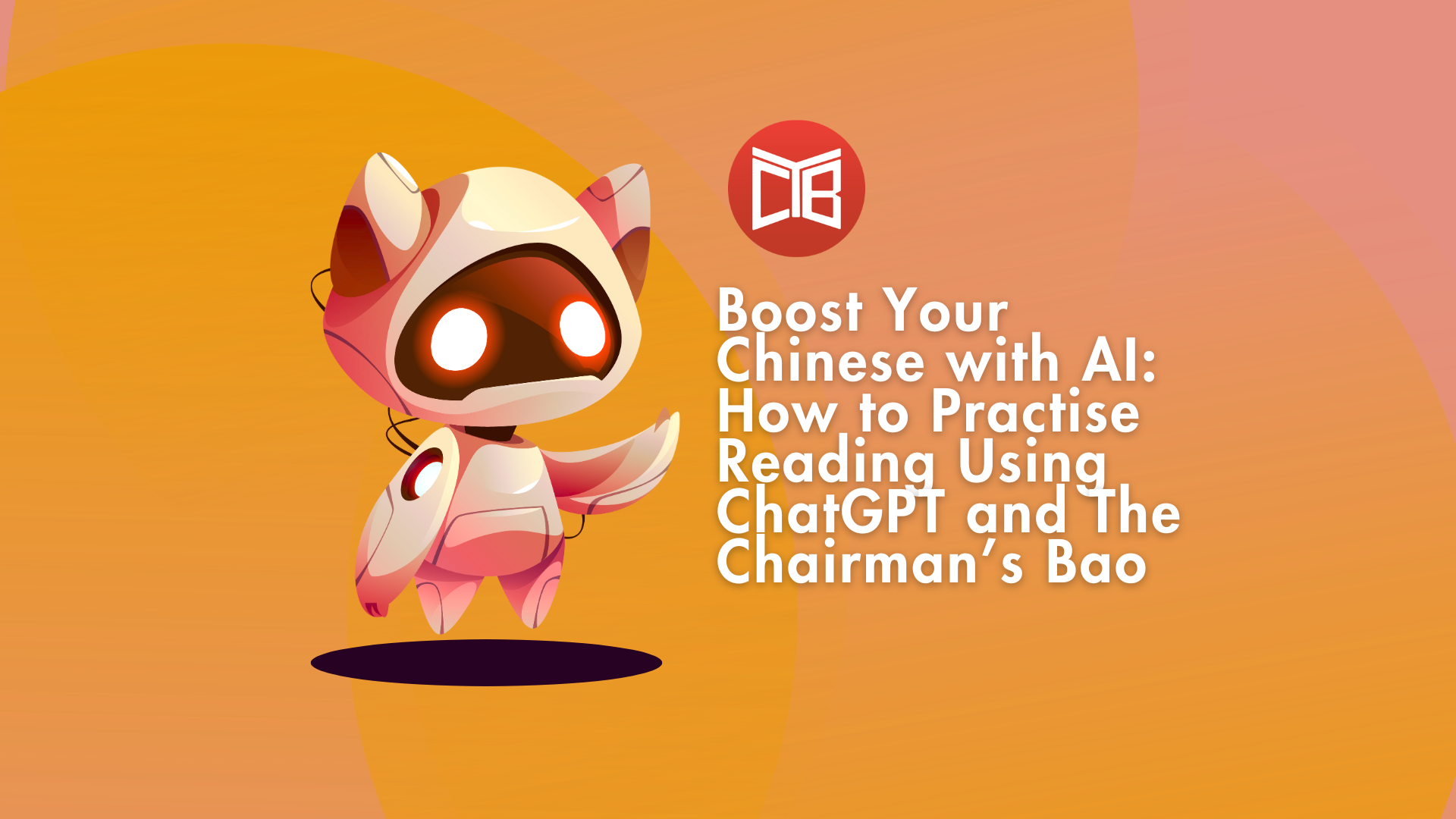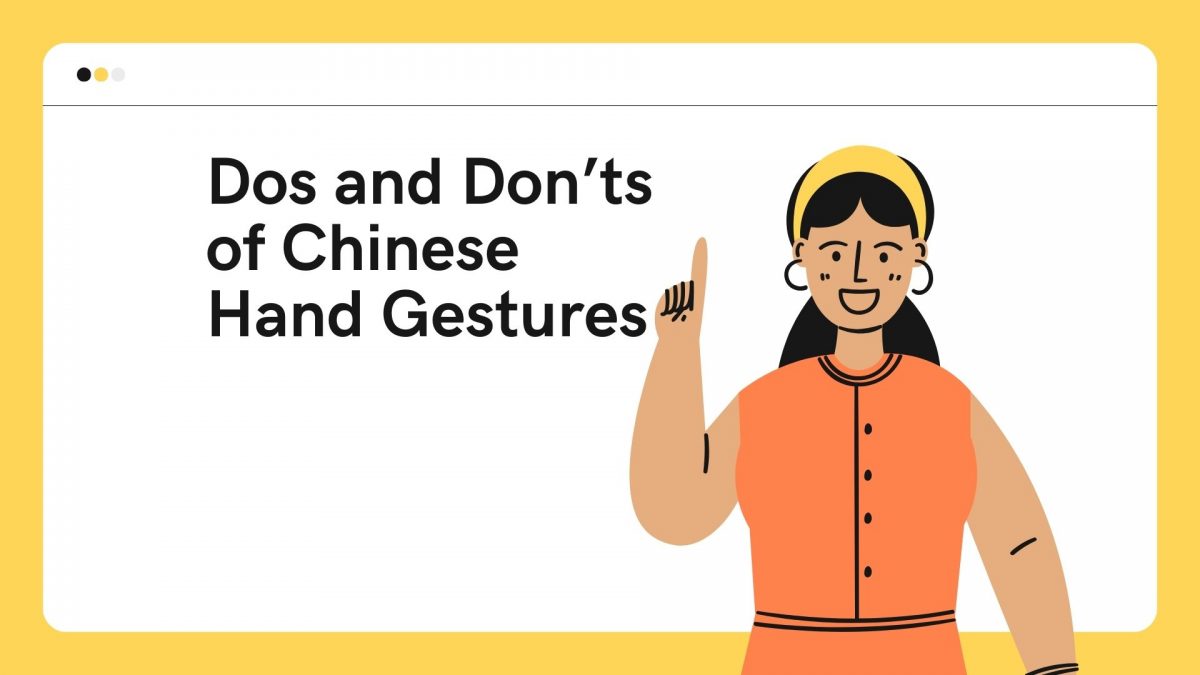
When learning Chinese, it’s important to understand the dos and don’ts of Chinese gestures to help break down language barriers. In this article, we delve into the world of gestures in China, as we explore the importance of nonverbal communication and the top 10 rude gestures to avoid in China. We will reveal the meaning of the middle finger in China and highlight the differences between Chinese and Western hand gestures. Let’s expand our understanding of the cultural significance of gestures in China!
Top 10 rude gestures to avoid in China
In this section, we will highlight the 10 rudest gestures to avoid in China that can make or break cultural interactions. Whether the universally recognised middle finger or the seemingly innocuous gesture of excessive hand movements, each gesture carries its own cultural importance. Let’s dive in with the rudest Chinese hand signals and gestures!
- Pointing with your index finger. In China, it is customary to point with all fingers using an open palm rather than a single pointing finger, which is considered rude. People will point with an open hand to indicate direction or call someone over. Never call someone over with your palm up and fingers wiggling. This can seem like you are trying to gesture an animal and is considered extremely disrespectful in Chinese culture.
- Giving the pinkie. It is often said that giving the pinkie finger in Chinese culture is the same as giving the middle finger in Western cultures. While giving the pinkie isn’t as offensive as the middle finger in China, it is still considered rude. Giving the pinkie can show that you believe the other person to be weak and feeble, as it’s the smallest, last finger on the hand.
- Middle finger. As in Western cultures, giving someone your middle finger is offensive in Chinese culture, signifying disrespect. Giving the middle finger is one of the most offensive hand gestures in China.
- Sucking in air loudly through your teeth. Making a loud sucking sound through one’s teeth is considered impolite in China and is often interpreted as a sign of annoyance or disapproval.
- Excessive hand movements. In Chinese culture, excessive hand movements can be seen as overly dramatic or disruptive, as they can convey impatience or annoyance.
- Winking, whistling or clicking your fingers at someone. These actions can be perceived as disrespectful or overly flirtatious in Chinese culture, especially in a professional context or with somebody you are not familiar with.
- Standing with your hands on your hips or crossing your arms. Standing with your hands on your hips or with arms crossed conveys arrogance or defensiveness in Chinese culture.
- Watch out for your feet. Pointing your feet towards someone, or touching someone with your feet, is considered impolite in Chinese culture. The feet are seen as the lowest and dirtiest part of the body.
- Too much PDA. Public displays of affection, such as bear hugs or excessive touching, are generally frowned upon in Chinese culture.
- Avoid prolonged eye contact. In Chinese culture prolonged eye contact can be interpreted as aggressive or confrontational. This contrasts with Western cultures where maintaining eye contact is often valued as a sign of confidence and assertiveness.
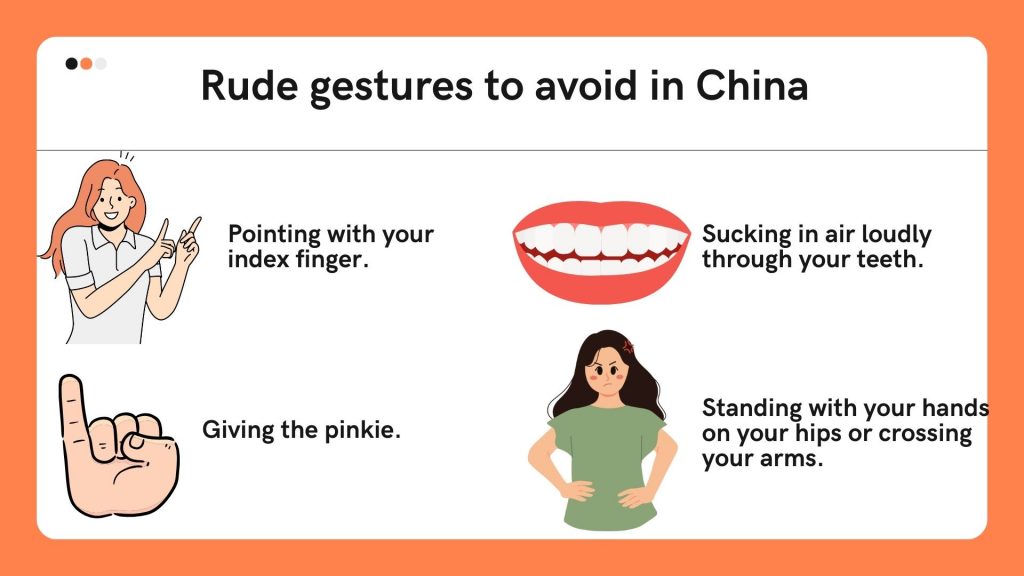
Top 5 positive gestures in China
In this section, we explore five positive Chinese gestures, ranging from expressions of gratitude to signs of goodwill. Let’s explore the most positive gestures in Chinese culture and their cultural importance!
- Thank you hand gesture. In Chinese culture, a palm placed over a fist with the other hand, often followed by a slight bow of the head, signifies gratitude.
- Gestures to wish good luck. Women wrap the left-hand around the closed right-hand to signify good fortune. For men, the right-hand wraps around the fist of the left-hand to express good luck.
- Bowing. A slight bow, often accompanied by clasped hands or a slight nod of the head, is a sign of respect and humility in Chinese culture. The depth and duration of the bow may vary depending on the situation and status of people involved.
- Handshake. The handshake has become more common in Chinese culture in recent decades, especially in business and formal settings. When offering a handshake in China, be sure to offer a firm but not overly aggressive grip to convey sincerity and mutual respect.
- Thumbs up. Thumbs up is not considered offensive in China. As in Western cultures, the Chinese thumbs up is generally seen as a sign of approval and agreement.
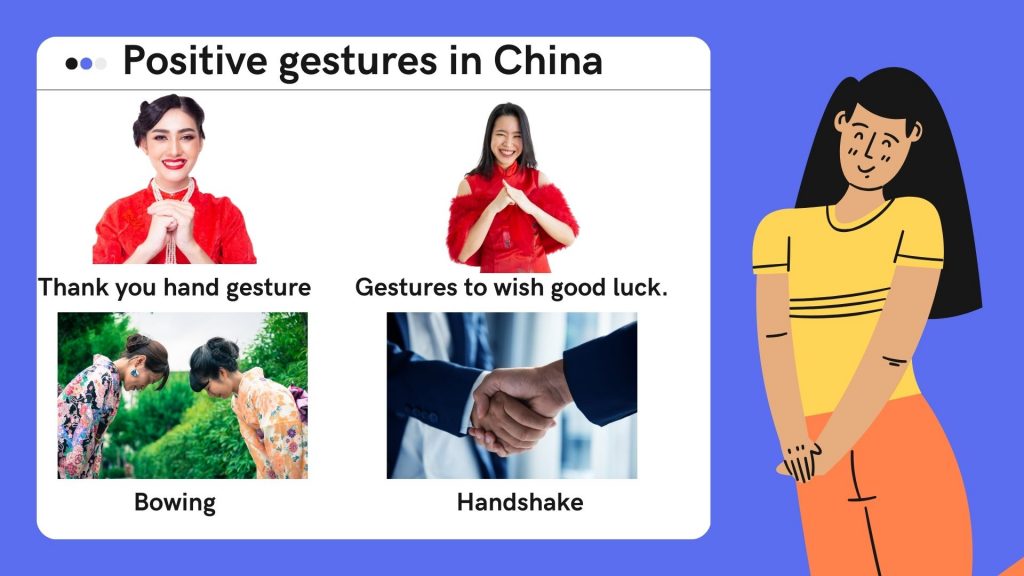
Chinese hand signs in context
In this section, we investigate how hand gestures are used in Chinese society, from business interactions to dining etiquettes and gift-giving customs. Let’s dive in!
Gestures for business in China
Understanding cultural significance of gestures is vital when doing business in China. Using appropriate gestures demonstrates respect and cultural sensitivity, helping to foster successful and prosperous business relationships.
- Be punctual. Being on time is highly valued in Chinese culture. Arriving late can be perceived as disrespectful and may undermine trust and credibility in the relationship. Always strive to arrive on time or a few minutes early to meetings and appointments.
- Observe hierarchical seating order. Seating order for business meetings in China follows hierarchical order. The most senior employees sit at the head of the table or in the central position directly facing the door. The most esteemed guests would be sat directly opposite the highest-ranking employees of the other company.
- Highest-ranking employee enters the room first. In Chinese business culture, the highest-ranking employee typically enters the room first as a symbol of respect.
- Use appropriate names and titles. Addressing colleagues and business partners with the appropriate names and titles is critical in Chinese business culture. Use formal titles such as “Mr.,” “Ms.,” or professional titles like “Director” or “Manager”, until invited to use first names.
- Don’t point with your finger. Pointing with your finger when doing business in China can be interpreted as a sign of aggression or confrontation. Instead, you should gesture with an open palm or a subtle nod in the direction to convey direction or instructions.
- Give and receive with both hands. When exchanging business cards or corporate gifts, use both hands to offer or receive items as a sign of respect and courtesy. You should then hold the item in both hands as you receive it with a slight bow or nod of the head to signify thanks.
- Be prepared to toast. Toasting, often with alcohol such as baijiu, is common practice at business meetings and celebrations in China. If you’re a guest, you should wait for the host to initiate a toast before taking a drink.
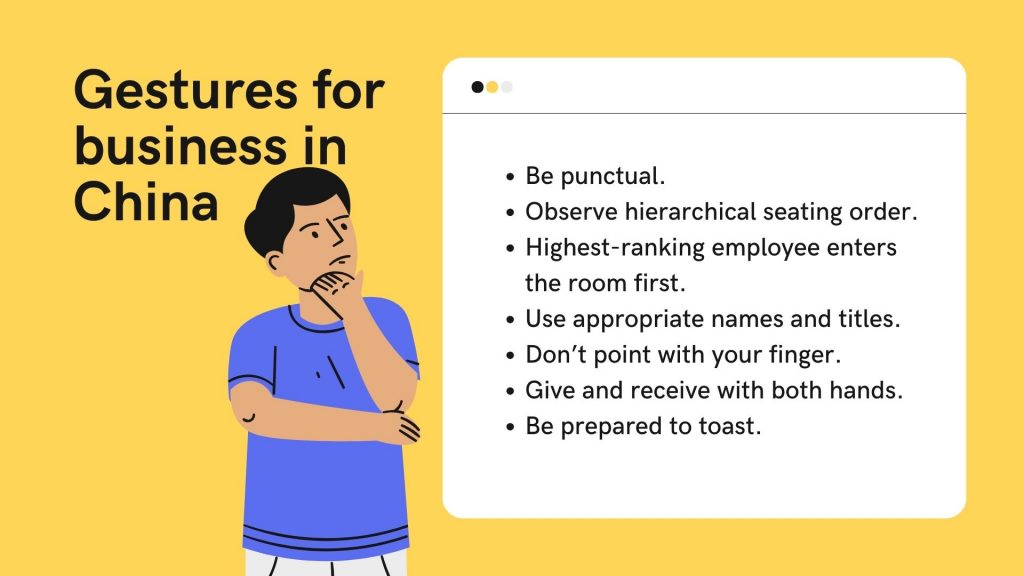
Important gestures for eating at a restaurant in China
China is a country of incredible culinary diversity, so it’s important to understand the gestures associated with dining out. Here are five important gestures to keep in mind when eating at a restaurant in China.
- Be punctual. Arrive on time, or better slightly early, for a meal in China. Arriving late can be a sign of disrespect to the host or organiser. Arriving too early can be a sign that you are too hungry and is also considered discourteous.
- Don’t stick your chopsticks in your food. Placing your chopsticks upright in a bowl of rice resembles a funeral ritual in Chinese culture in which incense are burnt to honour the deceased.
- Don’t point with your chopsticks. Pointing with your chopsticks is rude in Chinese culture and is reminiscent of being told off by someone. Instead, gesture with an open hand or a gentle nod of the head.
- Don’t finish all of your food. In Chinese culture, leaving a small amount of food uneaten is a sign of appreciation for the meal. It shows that your host or the restaurant provided enough food to make you full and content.
- Carefully place your chopsticks when finished eating. When finished eating, it is polite to leave your chopsticks across the top of your rice bowl, or on the chopstick holder. Do not stick them in your food or leave them misplaced around the table.
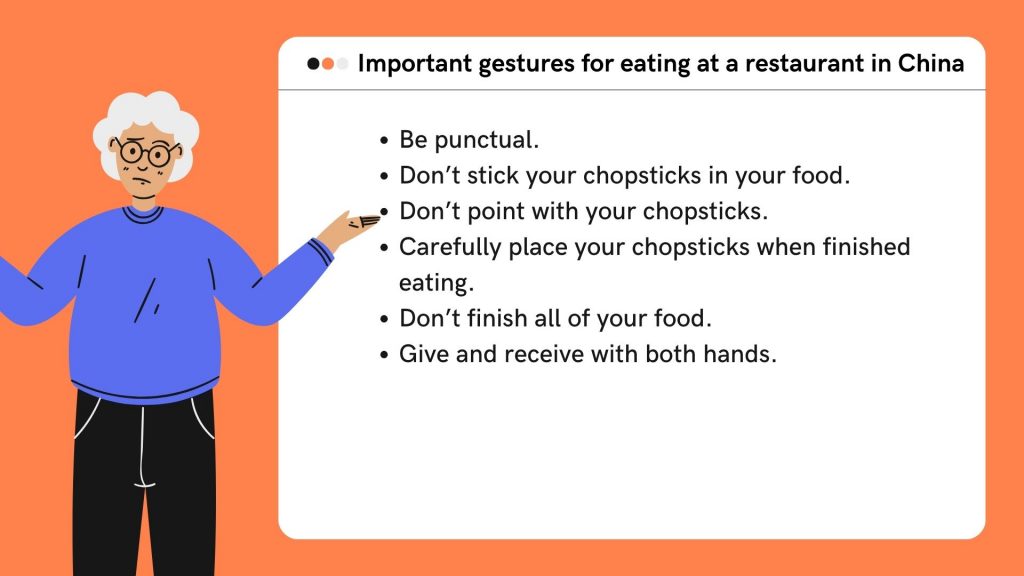
Gestures for gifting in Chinese culture
In Chinese culture, the gifting and receiving of gifts is extremely important and embodies respect, gratitude, and reciprocity. Understanding the proper gestures and etiquettes associated with gifting is essential when working or living in China. Here are four key gestures to keep in mind when giving or receiving gifts in China.
- Be careful what you are gifting. It’s vital to be considerate when choosing a gift in China. Avoid items that may carry negative connotations or superstitions, such as clocks, handkerchiefs, or items in sets of four, which symbolises death.
- Gift in age and hierarchical order. When giving gifts in China, it’s customary to start with the oldest or most senior recipients first. Younger or junior members of the group then receive their gifts, which demonstrates respect for the hierarchical group status.
- Present with both hands. When offering or receiving a gift, accept or give it with both hands. This symbolises your sincerity and shows respect toward the other party.
- Give a gift of equal value. In Chinese culture, reciprocity is valued and it’s important to give gifts of a comparable value to those you receive. This ensures balance in the exchange.
The evolution of Chinese gestures: history, trends and modern-day use
Chinese hand signs have been an integral part of communication in China since ancient times. Let’s uncover the evolution of gestures in China, exploring their historical roots, contemporary trends, and modern-day importance.
Historical roots of Chinese gestures
The history of Chinese gestures dates back thousands of years and can be traced back to roots in Confucianism, Taoism and other spiritual traditions. Gestures are not only used as a form of communication, but also to show respect and an understanding of social and formal hierarchy. Gestures such as bowing and expressions of good fortune play a crucial role in formal ceremonies such as weddings and everyday interactions in China.
Modern-day significance of gestures in China
In modern-day China, gestures continue to play a vital role in social and formal communication. As well as the importance of traditional gestures, in recent decades new gestures influenced by Western culture and digital communication have emerged. Handshakes, thumbs-up gestures, and emoji-based expressions are increasingly common, reflecting the fusion of traditional and modern elements in modern-day Chinese communication.
Using gestures to bridge language barriers in China
Gestures play a pivotal role in bridging language and breaking down cultural barriers when living or doing business in China. When studying Chinese, it is important to develop an understanding of nonverbal communication in China to build connections and relationships.
Is the middle finger rude in China?
The middle finger is seen as a rude gesture in Chinese culture. In ancient China, the middle finger held significance in spiritual traditions. In Chinese philosophy, the middle finger is associated with the element of fire, which is believed to possess strong mystical powers.
Magic and sorcery: history of the middle finger in China
In folk beliefs and superstitions, gestures involving the middle finger were believed to ward off evil spirits in Chinese culture. Historically, it was used in rituals to invoke supernatural forces or to place curses on one’s enemies.
Chinese gestures vs. Western gestures: the key differences
There are many differences between common hand gestures in Chinese and Western cultures and their cultural significance. Although these variations can be region- or place-specific, the key points can be summarised into the four areas expanded below.
- Eye contact. In Western cultures, maintaining eye contact is often seen as a show of strength and sincerity. However, in China it is considered impolite to hold someone’s eye contact for too long.
- Facial expressions. General facial expressions are shared between Chinese and Western cultures, such as smile and laughter. However, generally people in China are more reserved when expressing emotion, particularly when they are of a higher social or formal status.
- Hand gestures. In China, it is rude to point with your middle finger and an open palm or nod is used in its place. Playing with an item of jewellery or other expensive item during conversation can be considered as showing off wealth in China and should be avoided. In Western cultures, a similar gesture may be taken as a display of nervousness or discomfort.
- Touch. Public displays of affection are not as common in China as in some Western cultures. Although this is evolving somewhat as China becomes more globalised, it is not as common to see couples holding hands or kissing in public.
Other Asian hand gestures and their meanings
Across Asia, various hand gestures are used to convey different meanings and hold cultural significance. Here, we explore some other Asian hand gestures and their meanings.
- Peace sign. Formed by raising the index and middle fingers while keeping the remaining fingers folded, the peace sign is widely recognised as a symbol of peace and goodwill around the world. In many Asian countries such as Japan and South Korea, the peace sign is a popular hand gesture. In recent decades, the peace sign in China has emerged as a common gesture in photographs to convey friendship and positivity.
- OK sign. Created by forming a circle with the thumb and index finger while extending the remaining fingers, the OK sign typically signifies approval or agreement in Western cultures. However, in some parts of Asia, the OK sign can carry negative connotations.
- Fig sign. Made by curling the fingers into a fist with the thumb protruding between the index and middle fingers, the fig sign has various interpretations around the world. In Japan, it may be considered a sign of good fortune, whereas elsewhere in Asia it can be seen as a rude gesture.
Conclusion
Developing an understanding of the dos and don’ts of Chinese gestures is essential for navigating cultural interactions in China. From avoiding rude gestures like pointing with the index finger or giving the middle finger, to embracing positive gestures such as the thank you hand gesture, mastering Chinese gestures can play a vital role in business and social settings in China. Gestures can help to grow and reinforce relationships and ensure you stay appropriate during interactions in China.
FAQ
- Is the middle finger rude in China? Yes, giving the middle finger is extremely rude in Chinese culture.
- What gestures should I avoid when doing business in China? Avoid pointing with your finger, crossing your arms or putting your hands on your hips when doing business in China.
- What should I keep in mind when giving a gift to China? Avoid gifting anything with negative or inauspicious connotations when gifting in China, such as fresh flowers and clocks. Always give and receive gifts with both hands to express sincerity and gratitude!
- Is it acceptable to use Western hand gestures in China? While some Western hand gestures, such as the handshake and thumbs up sign, are becoming more common in China, it’s essential to be mindful of cultural differences and use them appropriately. Avoid gestures that may be perceived as rude or offensive in Chinese culture.
Author:
Sean speaking to students at Beths Grammar School about his experience of learning Chinese, living in China and founding Newsdle and The Chairman’s Bao.
Sean studied Chinese and Spanish at University of Leeds and founded The Chairman’s Bao alongside Tom Reid in his final year of study in 2015. Current Managing Director of The Chairman’s Bao, he has overseen the company’s growth from university bedroom concept to an international force in the EdTech industry with over 200,000 individual users and over 400 global partner institutions. Sean also launched Newsdle alongside Tom Reid and Oliver Leach in 2021, for students and teachers of Spanish and French. In his spare time, Sean is still a keen language learner and runner. He also sits on the Board of charity Leeds Irish Health and Homes in the UK.
Sean McGibney






